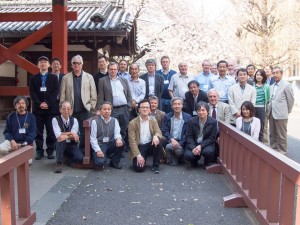
Group picture of the joint meeting of the conventional facilities and accelerator design and integration groups at Tokyo University. Image: Nobuko Kobayashi
The ILC baseline design as described in the Technical Design Report and its associated cost estimate was finalised in 2012. Since that time the design has been relatively static while the global high-energy physics community absorbed and responded to this information. During the past 12 months, significant progress in Japan has resulted in the choice of a preferred site together with a proposal to consider implementing the ILC project in a series of discrete energy stages rather than an initial 500- gigaelectronvolt (GeV) centre-of-mass energy. Thus the time is fitting to evolve the TDR baseline in response to these new eventualities. An initial step in this direction was taken recently in a three-day meeting at the University of Tokyo, which involved a joint team from the conventional facilities and accelerator design and integration groups.
The goals of the meeting were described thus: “This meeting will examine the scope of the pre-project CFS work, the schedule, and necessary resources. The detector hall concept at the proposed site, and the impact of energy phasing will also be addressed. The pre-project CFS timeline will likely drive many aspects of the accelerator design work in the next few years thus it is important to understand these constraints. In order to derive a site dependent ILC design and address long lead-time CFS activities then we need to assess what design information needs to be available to the CFS group and when. The ILC technical design in the TDR relied on a generic site description which is inadequate to proceed much further in the site specific design.”
During the LCWS13 meeting last November, it became apparent that in order to be consistent with a construction project which can start in 2018, a multi-year pre-construction programme centred around the conventional facilities work in Japan needed to start soon. In turn, this programme would need timely input from the site-specific accelerator design. Although three days is insufficient time to finalise anything, a consensus was achieved on many items which provides the necessary framework for how to proceed during the next few years. Next month’s Americas Workshop on Linear Collider to be held at Fermilab will build on this work.
Conventional facilities preparation for a construction project covers not only the detailed design of the tunnel, associated enclosures and the interaction region/damping ring complex but also such green-field related topics as land acquisition, environmental impact, geological and topographical studies. The schedule for this work depends to a certain degree on the available resources but it will require a minimum of several years. The meeting discussed the work scope and how best to proceed but there was little dissent from the conclusion that we need to start soon to remain consistent with a construction start in 2018 or thereabouts. This topic will provide the basis of a funding request for the long lead-time elements.
Intermediate energy operation at values less than 500 GeV is based on a partial installation of the main linac and has ramifications on many aspects of the project execution including such programme aspects as the cryomodule production rate, funding profiles and minor design changes to best accommodate lower energies. The exact details depend on the desired energy points and the associated integrated luminosity at these values. These specifications are currently under study by the parameters working group, but one critical conclusion from the meeting was the recognition that all the major convention construction needs to be completed as part of the first phase of any project. This result will now be used as input for subsequent planning.
A partial linac can be implemented in several ways. The basic variants consist of “missing” cryomodules at the upstream end, the downstream end or interspersed along the length. All of these approaches require the full injector complex, the complete beam delivery system and transport sections in the main tunnel. Emittance growth minimisation requires an initial accelerating section of at least 50 Ge,V which argues against a missing linac on the upstream end. Most discussions involved a solution which has the location of the accelerating sections determined by the baseline cryogenic infrastructure which satisfies the beam dynamics requirements and allows for some operational flexibility. This approach will be used for the future energy scaling discussions.
The preferred site has re-opened debate on the possibility of a vertical access shaft (or shafts) for the detector hall as opposed to, or in addition to, the baseline design which involved a horizontal access tunnel. This is complicated issue involving the detector construction technique, personnel safety, and exact location of interaction point as well as old favourites such as cost and schedule. More work is necessary before an optimal decision can be made but in order to start to restrict the potential phase space of solutions we decided to use the TDR baseline (horizontal) and the so-called Hybrid A (CMS-like) as the models for further study. The goal in this area is to converge on a solution by the end of this calendar year.
Several other topics such as the role of the central campus, safety issues arising from the tunnel design, and short-term activities were also part of the meeting. The looming LC NewsLine deadline suggests that these items be left for a later date – the talks are posted on the aforementioned web site for those of you who can’t bear to wait. The upcoming Fermilab workshop will provide the next forum for further face-to-face dialogue.
On behalf of the meeting participants I would like to thank the University of Tokyo and the support staff for arranging the meeting, the facilities, the excellent weather, the cherry blossom in bloom, and a damn good meal which appeared to materialise in a mysterious and spontaneous fashion courtesy of the physics department.


Recent Comments